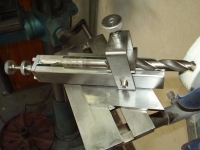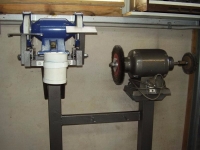
Originally Posted by
th62

This is a drill sharpening jig I made some time ago and the grinder setup I use it on. The grinder is just an el cheapo, I've been meaning to change the grinder as the wheels wobble all over the place. One day I may even get around to replacing it.
Anyway some details on both.
The Jig:
I used a piece of 25mm square bar, linished it, milled a V for the drill, cut a 2mm slot down the centre for 110mm, drilled a stepped hole through: 5mm for 30mm and then 11.5 mm for the remaining 110mm. I had to extend an old 11.5mm drill and grind flat on the end so I could machine the end of the hole flat for a stepped bush to run on. I also drilled a couple of debris drain holes and tapped a few 5mm holes for mounting the slide plate, the end plate and the drill clamp. As you can see from the pics there are quite a few bits inside.
The 5mm advance rod was turned down to 3.5 on the end and a 5mm bush with collar was shrunk in place for the end bushing. I turned a bit of stock to 7mm, threaded the inside to 5mm x .8, fashioned a single wing and tacked it to the nut. The bush on the advance end was machined to 7mm with a collar, machined down to fit a 9mm spanner, and threaded inside the same as the advance screw. When screwed into place itís locked off with a locknut. The plate on the end has a backlash adjuster and locknut and also acts as the outer bearing for the advance screw bush. The end plate is fixed by two 5mm allen heads which I had to turn down to accommodate the backlash adjuster locknut. To the rear of that are the thumb lock nut and the thumb adjuster.
The drill clamp U piece is attached via two 5mm allen heads. I machined a stepped 5mm nut and shrunk it into the top of the U piece. The adjuster screw has a thumb nut attached at the top and the adjuster screw pushes an H shaped plate down onto the drill flutes.
It will accommodate drills from 13mm down to 2mm, larger bits are probably better ground using a simple conical grinding jig attached to a linisher. Anything under 4 or 5mm would be difficult to grind accurately on this jig, so another project would be for a jig with a drill chuck for smaller bits.
In use: The drill is secured in place by the adjuster and H plate. To advance the drill onto the grindstone, the advance thumbnut is turned and the single winged nut moves along the advance screw, guided by the slot in the bed, and acts on the rear of drill pushing it forward and onto the grindstone...
Over complicated? Sure is, but it works well; and, it was an excellent project to design and make.
The grinder and tables:
The framework you see in the picture is made from 25 x 1.6mm RHS. each side has two rails along which slide the table supports, they can be adjusted for angle as well as reach. There are also a couple of L shaped plates to which the table stem mounting bolts are welded. These brackets stop the bolts turning when tightening the stem securing nuts.
The table has scribed lines at 0, 30, 45, 60 and 90 degrees, the other two tables have slots, one for the drill jig the other for a lathe bit sharpener.
I joined this grinder stand to my 8" grinder stand with a short section of 50 x 25mm RHS. The 8" runs a wire wheel and buffing pads (horrid job). The 6" grinder is set at around chest height so I don't have to stoop whereas the 8" is set much lower. I also stripped, cleaned and tidied up the wiring underneath and then painted it in hammertone along with the stand. There is also a water trough at front so I don't have to go searching for a water bucket at inopportune times.
I've been using the jig and grinder for quite a while now, I do wish I had made the table stems and rails from gal RHS though as the paint tends to peel off from the constant changing of table position.


 LinkBack URL
LinkBack URL About LinkBacks
About LinkBacks


 Reply With Quote
Reply With Quote





Bookmarks